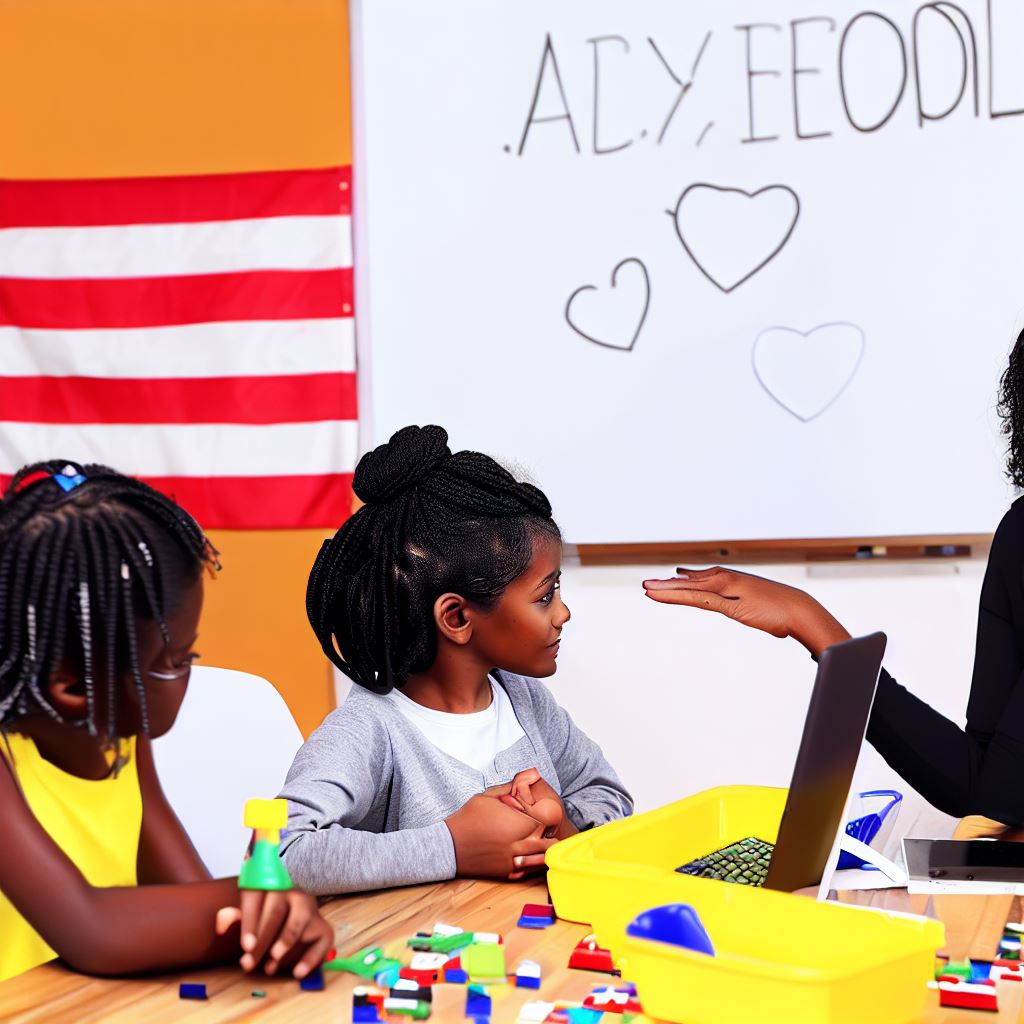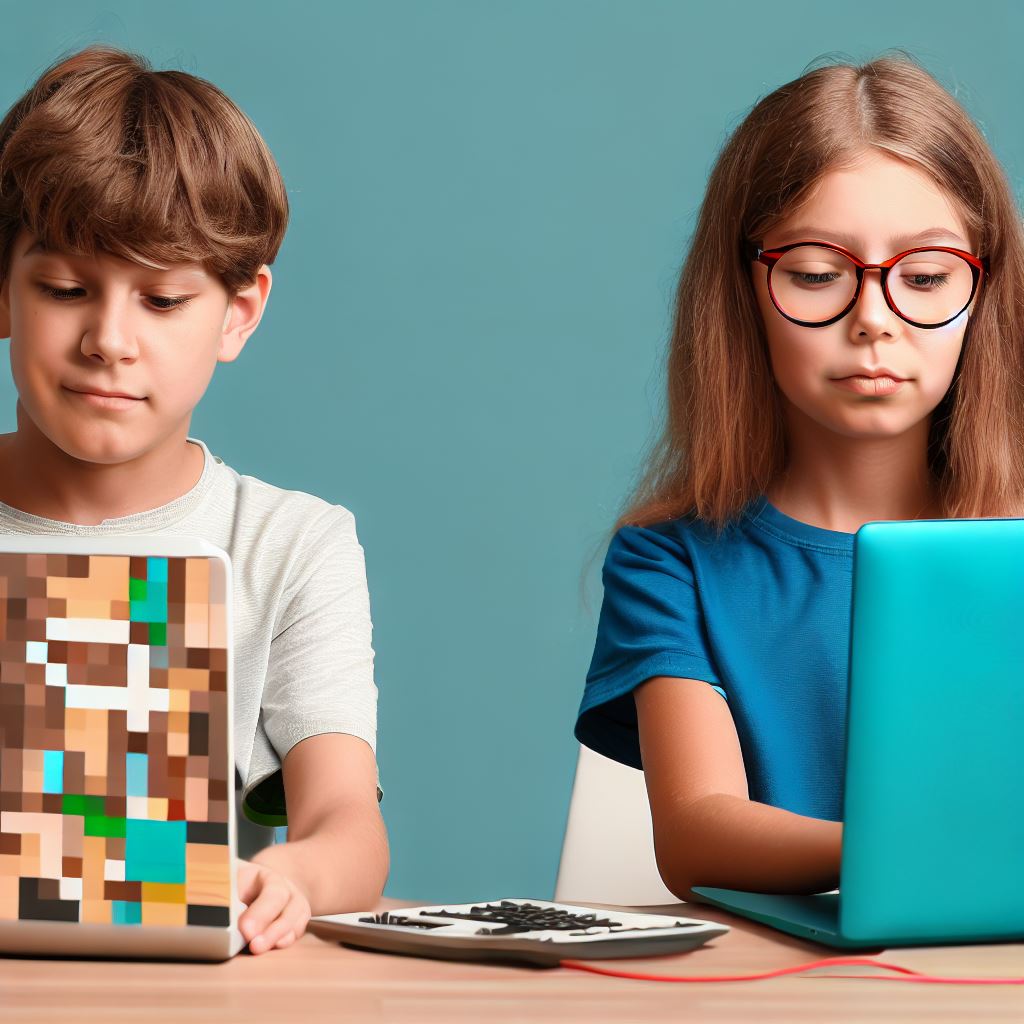Introduction
In the digital age, teaching kids coding has become increasingly important. Learning to code at a young age offers numerous benefits.
Coding is not only a valuable skill for future job prospects, but it also enhances problem-solving abilities. It fosters creativity and critical thinking.
By teaching kids coding, parents can equip them with essential skills for the future. Children can develop logical thinking and analytical skills.
Furthermore, coding encourages perseverance and resilience. It teaches kids to break complex problems into smaller, manageable tasks.
Learning coding at a young age also promotes teamwork and collaboration. Kids often participate in coding clubs or work together on projects, developing social skills.
Moreover, coding nurtures innovation and entrepreneurship. It empowers children to transform their ideas into reality and create their own software or games.
Additionally, coding enhances computational thinking. It enables kids to understand algorithms, processes, and patterns, improving their overall problem-solving abilities.
Overall, teaching kids coding is crucial in preparing them for the digital world. It empowers them with skills that will be highly sought after in the future job market.
As parents, it is essential to recognize the importance of coding education and provide opportunities for children to learn and explore this valuable skill.
Why Coding is Important for Kids
Coding has become an essential skill for kids in the 21st century. Here’s why it’s important:
1. Develops Computational Thinking
- Coding helps kids understand how to break down complex problems into smaller, manageable parts.
- It encourages them to think logically and sequence instructions in a specific order.
- Kids learn to identify patterns, make connections, and use algorithms to solve problems.
2. Enhances Problem-Solving Skills
- Through coding, kids learn to approach challenges with a systematic and analytical mindset.
- They acquire the ability to identify problems, propose solutions, and evaluate their effectiveness.
- These problem-solving skills are transferable and applicable in various aspects of life.
3. Stimulates Critical Thinking
- Coding fosters the development of critical thinking skills in kids.
- They learn to analyze situations, assess options, and make informed decisions.
- Critical thinking empowers children to become independent learners and innovative thinkers.
4. Encourages Creativity
- Coding is a creative process that allows kids to express their ideas and imagination.
- They can create interactive stories, games, animations, and even websites.
- By experimenting and problem-solving, they unleash their creativity and bring ideas to life.
5. Builds Resilience and Perseverance
- Coding requires trial and error, and kids learn to persist in the face of challenges.
- They develop resilience by learning from failures, making improvements, and trying again.
- These qualities are crucial for success in coding and transferable to other areas of life.
6. Fosters Collaboration and Communication
- Coding projects often involve teamwork, encouraging kids to collaborate and communicate effectively.
- They learn to listen, share ideas, give and receive feedback, and work towards a common goal.
- These skills are valuable in real-world scenarios, not just in programming.
7. Provides Future Job Opportunities
- Coding is a key skill that is increasingly in demand in the job market.
- By learning to code early, kids gain a competitive advantage for future career opportunities.
- It opens doors in fields like software development, technology, and innovation.
In summary, coding is crucial for kids as it develops computational thinking, problem-solving, critical thinking, creativity, resilience, collaboration, and communication, and provides future job opportunities.
Start teaching your kids coding today!
Read: 5 Hidden Features on CodingBat You Should Know
Best Practices for Teaching Kids Coding: A Parent’s Guide
Start Early
- Introduce age-appropriate coding concepts to your kids.
- Teach coding through games and interactive activities.
- Explore coding apps and online platforms designed for young learners.
- Encourage problem-solving and critical thinking skills through coding exercises.
Make It Fun
- Use colorful visuals and engaging storytelling to capture your child’s attention.
- Incorporate gamification elements to motivate and reward your child’s coding progress.
- Provide hands-on experiences with robots, drones, and other tangible coding tools.
- Organize coding competitions or challenges to foster a sense of excitement and achievement.
Break It Down
- Teach coding concepts in small, manageable chunks to avoid overwhelming your child.
- Break complex problems into simpler steps to develop logical reasoning skills.
- Encourage your child to create flowcharts or diagrams to map out their coding process.
- Emphasize the importance of debugging and troubleshooting to improve coding skills.
Personalize Learning
- Cater to your child’s interests by incorporating coding projects related to their hobbies.
- Allow your child to choose the programming language or platform that excites them.
- Offer guidance and support, but let your child take ownership of their coding journey.
- Provide opportunities for your child to showcase their coding projects and share with others.
Encourage Collaboration
- Facilitate coding clubs or group activities for your child to collaborate with peers.
- Encourage your child to participate in coding competitions or join coding communities online.
- Teach your child the importance of teamwork and communication in coding projects.
- Foster a supportive and inclusive environment where everyone’s contributions are valued.
Celebrate Achievements
- Praise your child for their coding efforts, even for small accomplishments.
- Display their coding projects or achievements in a visible place at home.
- Celebrate milestones with small rewards or treats to keep your child motivated.
- Recognize the growth and progress your child has made in their coding skills.
Instill a Growth Mindset
- Teach your child that coding is a skill that can be improved with practice and perseverance.
- Emphasize the value of learning from mistakes and embracing challenges in coding.
- Encourage a positive attitude towards problem-solving and continuous learning.
- Inspire your child to explore new coding projects and push their boundaries.
Provide Real-Life Applications
- Connect coding concepts to real-life examples to demonstrate their relevance.
- Encourage your child to create coding projects that solve everyday problems.
- Show how coding is used in various industries and career paths.
- Inspire your child to pursue future opportunities in STEM fields through coding.
Stay Involved and Supportive
- Stay informed about the latest advancements and trends in coding education.
- Offer assistance and guidance when your child encounters coding challenges.
- Explore coding resources, workshops, and classes together with your child.
- Show genuine interest in your child’s coding projects and accomplishments.
By following these best practices, parents can effectively teach kids coding and inspire them to become lifelong learners in the digital age.
Read: How Coding Bootcamps Are Bridging the Tech Skills Gap
Tech Consulting Tailored to Your Coding Journey
Get expert guidance in coding with a personalized consultation. Receive unique, actionable insights delivered in 1-3 business days.
Get StartedKeep It Fun and Engaging
When it comes to teaching kids coding, one of the essential factors is to ensure that the learning process is fun and engaging.
By incorporating gamification elements and using storytelling to connect coding concepts, parents can make coding enjoyable for their children.
Here are some effective strategies to achieve this:
Incorporate Gamification Elements
- Introduce coding through interactive games and puzzles that challenge children’s problem-solving skills.
- Create a rewards system where kids earn badges or points for completing coding tasks or reaching specific milestones.
- Organize coding competitions or challenges to encourage healthy competition among children.
- Utilize game-based coding platforms or apps that offer a visually appealing and immersive coding experience.
- Provide instant feedback and celebrate small achievements to keep children motivated and engaged.
By infusing coding with elements of playfulness and competition, children are more likely to stay enthusiastic about learning to code.
Use Storytelling to Connect Coding Concepts
- Introduce coding concepts through captivating stories or narratives that relate to real-world scenarios.
- Create characters or scenarios that children can identify with and make coding concepts more relatable.
- Guide children through storytelling activities where they write their own code to solve a problem within the story.
- Encourage children to create their own stories or animations using coding languages or coding tools.
- Explore interactive storytelling platforms or coding apps that allow kids to bring their stories to life through coding.
Storytelling provides a context for children to understand and apply coding concepts, making the learning process more engaging and meaningful.
Overall, keeping coding fun and engaging for kids is crucial in nurturing their interest and enthusiasm for learning.
By incorporating gamification elements and utilizing storytelling, parents can create an environment that encourages active participation and creative thinking.
Remember to adapt these strategies based on your child’s age, interests, and learning style to ensure the best possible coding experience.
Read: Post Bootcamp: Landing Your First Developer Job

Encourage Collaboration
Promoting teamwork and communication skills is crucial when teaching kids coding.
By encouraging collaboration, parents can enhance their child’s learning experience and foster a positive coding community.
Promoting Teamwork and Communication Skills
Collaboration plays a vital role in developing essential interpersonal skills.
When children work together on coding projects, they learn how to communicate effectively, share ideas, and solve problems as a team. T
hese skills are invaluable in the world of coding and beyond.
Build Your Vision, Perfectly Tailored
Get a custom-built website or application that matches your vision and needs. Stand out from the crowd with a solution designed just for you—professional, scalable, and seamless.
Get StartedParents can encourage teamwork by facilitating coding activities that require joint effort.
For example, they can assign coding projects that involve two or more kids working together, allowing them to learn from each other and develop a sense of camaraderie.
Organizing Coding Clubs or Workshops for Kids to Interact
To further promote collaboration, parents can organize coding clubs or workshops where kids can interact with their peers who share similar interests.
These clubs provide a platform for children to collaborate on coding projects, exchange ideas, and learn from one another.
Organizing such events can be done through community centers, schools, or even online platforms.
These clubs or workshops allow kids to connect with like-minded individuals, fostering an environment of support and encouragement.
When kids work together in a coding club or workshop, they not only gain technical knowledge but also develop crucial social skills.
They learn how to work in a team, listen to others’ perspectives, and express their ideas effectively.
The Benefits of Collaboration in Coding Education
Encouraging collaboration in teaching coding to kids has numerous benefits that go beyond technical skills:
- Enhanced problem-solving abilities: When working collaboratively, kids can tackle complex coding challenges by pooling their knowledge and skills.
- Increased creativity: By sharing ideas and brainstorming together, kids can expand their creative thinking and develop innovative solutions.
- Boosted self-confidence: Collaborative coding projects allow children to contribute their unique skills and ideas, boosting their self-esteem.
- Improved communication skills: Through collaboration, kids learn how to effectively communicate their thoughts and ideas, a vital skill in any field.
- Building a coding community: Collaboration creates a sense of belonging and encourages kids to engage with others who share their passion for coding.
By actively promoting collaboration during coding lessons, parents can help their children develop not only coding skills but also valuable life skills.
Teaching kids coding is not just about technical knowledge; it’s also about fostering collaboration and teamwork.
Parents can actively promote collaboration by encouraging joint coding projects, organizing coding clubs or workshops, and providing platforms for kids to interact with peers.
By doing so, parents can help their children develop crucial interpersonal skills, problem-solving abilities, and a sense of belonging within the coding community.
Read: Online vs. In-Person Bootcamps: Pros and Cons Reviewed
Optimize Your Profile, Get Noticed
Make your resume and LinkedIn stand out to employers with a profile that highlights your technical skills and project experience. Elevate your career with a polished and professional presence.
Get NoticedUse Visual Programming Languages
Visual programming languages like Scratch or Blockly offer an interactive and fun introduction to coding for kids.
These languages utilize a graphical interface, allowing children to construct programs by dragging and dropping blocks or visual elements.
The benefits of using visual programming languages in teaching coding to kids are numerous:
- Introduces coding concepts in an engaging manner with user-friendly drag-and-drop interfaces.
- Provides visual representations of coding concepts, making them more comprehensible and accessible.
- Encourages logical thinking and problem-solving by breaking down tasks into manageable steps.
- Fosters creativity and experimentation through colorful blocks, characters, and backgrounds for project creation.
- Offers instant feedback and allows for easy identification and correction of errors, developing troubleshooting skills.
Balancing guided instruction with independent exploration is crucial.
Parents can start by demonstrating the tool and explaining basics, then encouraging experimentation. Gradually introduce more complex concepts and challenges as proficiency grows.
Collaborative coding projects enhance learning through shared ideas and solutions.
Online resources, tutorials, and coding communities tailored for kids using visual programming languages provide additional support and project ideas.
They also offer platforms for sharing and showcasing creations.
Incorporating visual programming languages like Scratch or Blockly significantly enriches the coding learning experience for kids.
These languages promote logical thinking, creativity, problem-solving, and offer instant feedback.
Parents play a vital role in guiding and facilitating the learning process, enabling independent exploration and collaboration opportunities.
Provide Hands-On Experiences
Teaching kids coding is an exciting endeavor for parents and children alike. To ensure effective learning, incorporate hands-on experiences.
Use physical coding kits and robots, encouraging tangible understanding. Engage kids in real-life coding projects related to their interests.
Provide age-appropriate challenges to maintain engagement. Foster creativity and exploration in coding challenges. Encourage collaboration and project sharing with peers.
Integrate coding into everyday activities for practical application. Encourage documentation and reflection on coding projects.
Celebrate coding milestones and achievements to boost confidence and motivation. Break down complex concepts into smaller, digestible parts.
Simplify ideas with relatable examples and step-by-step instructions. Gradually introduce complexity to build a strong foundation.
Use visual aids and interactive tools for better comprehension. Engage kids in hands-on coding projects for practical application.
Foster curiosity, critical thinking, and problem-solving skills. Provide access to online resources and coding clubs for peer learning.
Remember, teaching coding is about instilling a love for learning and problem-solving.
Foster Problem-Solving Skills
To teach kids coding effectively, focus on fostering problem-solving skills with these key strategies:
- Encourage perseverance and resilience in finding solutions to coding challenges.
- Present coding puzzles to stimulate critical thinking and logical problem-solving.
- Teach kids to break down complex problems into smaller, manageable tasks for easier tackling.
- Foster an environment of experimentation and trial/error to encourage learning from mistakes.
- Provide coding resources like books, online tutorials, and platforms to expose kids to various techniques.
- Encourage collaboration and peer learning for diverse perspectives and teamwork skills.
- Integrate real-life applications into coding challenges for relatability and engagement.
- Celebrate successes and offer constructive feedback to further enhance problem-solving skills.
- Teach systematic debugging techniques, including error identification, isolation, and testing.
- Emphasize algorithmic thinking by analyzing problems and devising logical step-by-step solutions.
By incorporating these practices, kids will develop strong problem-solving skills crucial for coding success and beyond.
You Might Also Like: Advantages of Using CodeHS in American High Schools
Support Individuality and Creativity
To teach kids coding effectively, prioritize individuality and creativity with these strategies:
- Allow freedom in project choice, empowering them to pursue their passions and take ownership.
- Encourage problem-solving through independent project exploration, building self-reliance and critical thinking.
- Foster innovative thinking by prompting unconventional approaches to coding challenges.
- Advocate experimentation, embracing risks and failures as valuable learning experiences for growth.
- Provide diverse coding resources like online platforms, books, and interactive games to explore different languages.
- Create a supportive, non-judgmental environment for sharing projects, boosting confidence and facilitating feedback.
- Be a facilitator, offering guidance while empowering kids to take charge of their coding endeavors.
These practices nurture creativity and individuality, laying a strong foundation for coding success.
Available resources for teaching kids coding
Parents have a plethora of resources for teaching kids coding, facilitating an engaging learning experience. These include:
Online Coding Platforms and Tutorials:
- Code.org offers kid-friendly coding courses with interactive activities and games.
- Scratch, a visual language, fosters logical thinking through interactive story, game, and animation creation.
- Tynker provides interactive courses for game creation and robotics, promoting coding skills development.
- Khan Academy offers coding courses covering JavaScript, HTML/CSS, and computer science principles.
Coding Books and Guides for Parents:
- “Coding Games in Scratch” by Jon Woodcock introduces coding through game creation.
- “Hello Ruby: Adventures in Coding” by Linda Liukas teaches programming fundamentals through storytelling.
- “Coding for Kids: Python” by Adrienne B. Tacke provides step-by-step instructions for Python projects.
- “Coding Projects in Scratch” by DK Children offers progressively complex coding projects for skill development.
Coding Camps and Classes for Kids:
- Codecademy Kids provides online and in-person classes with real-world examples and interactive projects.
- ID Tech Camps offer hands-on coding experiences, covering various programming languages and technologies.
- Coding Dojo’s bootcamps delve deep into coding, enhancing problem-solving abilities.
- STEM For Kids integrates coding with STEM subjects in classes and camps.
In summary, parents have a wealth of resources, including online platforms, books, and camps, to teach kids coding effectively.
These resources cater to various learning preferences, ensuring an engaging and educational experience for children.
With these tools, parents can empower their kids to acquire vital coding skills, preparing them for a digital future.
Conclusion
To recap, teaching kids coding requires a combination of hands-on activities, interactive learning tools, and supportive environments.
It is important for parents to encourage and support their children’s interest in coding, as it can lead to future success in a digital world.
Recap of Best Practices for Teaching Kids Coding:
- Start Early: Introduce coding concepts gradually, even before formal lessons.
- Engage Creativity: Encourage kids to apply coding creatively through games and projects.
- Hands-On Learning: Use interactive tools and platforms to make coding enjoyable.
- Patience and Persistence: Foster resilience and problem-solving skills.
- Positive Reinforcement: Celebrate achievements and provide positive feedback.
Importance of Supporting Children’s Interest in Coding for Future Success in a Digital World:
- Digital Literacy: Coding is a fundamental skill in the digital age.
- Problem Solving: Coding enhances critical thinking and analytical abilities.
- Career Opportunities: Early exposure to coding can open doors to future tech careers.
- Innovation: Coding fosters creativity and innovation, key to success in a technology-driven world.
By supporting your child’s coding journey, you’re equipping them with invaluable skills and preparing them for a future of endless possibilities in the digital realm.




